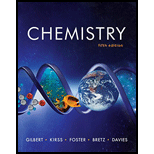
Concept explainers
Interpretation: The path followed by emitted alpha and beta particles is to be identified.
Concept introduction: The radioactivity is a process in which an unstable nucleus releases its energy by emitting alpha rays, beta rays and gamma rays. The path of these radiations changes as they move through electric field.
The alpha particles consist of positively charged helium atoms whereas beta particles consist of negatively charged electrons.
To determine: The path followed by the emitted alpha and beta particle
Answer to Problem 2.1VP
Solution
The path followed by the emitted alpha and beta particle has been identified.
Explanation of Solution
Explanation
The path of emitted alpha and beta particle is shown in Figure 1 in red and green color.

Figure 1
The emitted alpha and beta particles are passed through electric field and they deviate from each other. The radiation shown in green color move towards positive plate while red move towards negative plate.
This indicates that red line consists of positive charged alpha particles and green line shows the presence of negatively charged beta particles.
Conclusion
The path followed by the emitted alpha and beta particle has been
identified
Want to see more full solutions like this?
Chapter 2 Solutions
Chemistry: The Science in Context (Fifth Edition)
 ChemistryChemistryISBN:9781305957404Author:Steven S. Zumdahl, Susan A. Zumdahl, Donald J. DeCostePublisher:Cengage Learning
ChemistryChemistryISBN:9781305957404Author:Steven S. Zumdahl, Susan A. Zumdahl, Donald J. DeCostePublisher:Cengage Learning ChemistryChemistryISBN:9781259911156Author:Raymond Chang Dr., Jason Overby ProfessorPublisher:McGraw-Hill Education
ChemistryChemistryISBN:9781259911156Author:Raymond Chang Dr., Jason Overby ProfessorPublisher:McGraw-Hill Education Principles of Instrumental AnalysisChemistryISBN:9781305577213Author:Douglas A. Skoog, F. James Holler, Stanley R. CrouchPublisher:Cengage Learning
Principles of Instrumental AnalysisChemistryISBN:9781305577213Author:Douglas A. Skoog, F. James Holler, Stanley R. CrouchPublisher:Cengage Learning Organic ChemistryChemistryISBN:9780078021558Author:Janice Gorzynski Smith Dr.Publisher:McGraw-Hill Education
Organic ChemistryChemistryISBN:9780078021558Author:Janice Gorzynski Smith Dr.Publisher:McGraw-Hill Education Chemistry: Principles and ReactionsChemistryISBN:9781305079373Author:William L. Masterton, Cecile N. HurleyPublisher:Cengage Learning
Chemistry: Principles and ReactionsChemistryISBN:9781305079373Author:William L. Masterton, Cecile N. HurleyPublisher:Cengage Learning Elementary Principles of Chemical Processes, Bind...ChemistryISBN:9781118431221Author:Richard M. Felder, Ronald W. Rousseau, Lisa G. BullardPublisher:WILEY
Elementary Principles of Chemical Processes, Bind...ChemistryISBN:9781118431221Author:Richard M. Felder, Ronald W. Rousseau, Lisa G. BullardPublisher:WILEY





